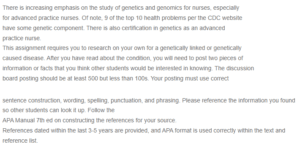Sickle Cell Anemia
Sickle cell disease is a genetic blood disorder that interferes with the morphology of red blood cells or erythrocytes. It occurs due to autosomal recessive inheritance of a mutation in the short arm of chromosome 11(Tisdale, Thein & Eaton, 2020). The exact position is at the beta-globin gene. The mutation causes the formation of valine instead of glutamic acid in the 6th position of the beta-globin gene. This results in the formation of abnormal hemoglobin, known as hemoglobin S (HbS).
Do you need an original copy on “Sickle Cell Anemia” ? Reach out to us.
Erythrocytes transport oxygen to the body’s tissues. When body tissues are exposed to oxidative stress, erythrocytes travel through narrow capillaries to reach them and supply antioxidants. The erythrocytes must change shape to pass through the capillaries (Vona et al., 2021). Normal hemoglobin enables them to change shape and easily pass through. When erythrocytes with HbS are exposed to oxidative stress, they polymerize and become sickled-shaped. This shape makes it difficult for the erythrocytes to pass through narrow capillaries. Therefore, body tissues are not supplied with antioxidants or oxygen, leading to tissue injury or death.
Additionally, sickle erythrocytes have a shorter life span. The average erythrocyte life span is 120 days. Sickle erythrocytes have a lifespan of 17 to 20 days (Vona et al., 2021). This short life span causes a deficit of hemoglobin, causing anemia. In anemia, the body does not get enough oxygen. This manifests as awareness of heartbeat, dizziness, and easy fatigability. The abnormal erythrocytes also get trapped in the spleen. This leads to an accumulation of blood in the spleen and a low supply to other body parts. It also leads to enlargement of the spleen.
Sickling of erythrocytes is triggered by low availability of oxygen. Low oxygen levels cause polymerization and sickling of red blood cells. Factors that cause low oxygen availability include extremes of temperatures, vigorous physical exercise, infection, pregnancy, alcohol use, systemic illness such as diabetes mellitus, mental strain, dehydration, and respiratory or metabolic acidosis. These factors can cause a sickle cell crisis. There are different types of crises (Pinto et al., 2019)—for instance, pain, sequestration, aplastic, and acute chest syndrome.
Pain crisis manifests as repeated, severe painful episodes in the limbs, chest, and abdomen. It occurs due to poor blood and inadequate oxygen supply to the body’s tissues. Lack of oxygen in the tissues leads to cell death (Pinto et al., 2019). This causes burning pain in character and shifts from one area to another. Management will depend on the severity of the pain. If the pain is mild, the patient can be managed at home with bed rest and oral analgesics. If the pain is severe, the patient is admitted to the hospital for management with intravenous analgesics.
Sequestration crisis occurs due to accumulated sickled red blood cells in the organs. It can be hepatic or splenic sequestration (Pinto et al., 2019). Hepatic sequestration presents as upper right quadrant pain. Splenic sequestration presents as upper left quadrant pain. The pain is due to stretching of the hepatic capsule in hepatic sequestration and the splenic capsule in splenic sequestration. An aplastic crisis is the termination of the production of erythrocytes. The most common cause of aplastic crises is parvovirus B19 (Klings & Steinberg, 2022). It presents with severe anemia. Furthermore, it can lead to loss of consciousness. Patients with the aplastic crisis are usually transfused.
Acute chest syndrome is characterized by difficulty in breathing and coughing. Fever may also be present. Intervention should be fast because acute chest syndrome is the second most common cause of death in patients with sickle cell anemia (Klings & Steinberg, 2022). Lab investigations, such as complete blood count, renal function tests, liver function tests, and blood and sputum for culture and sensitivity, should be done. Imaging investigations such as chest X-rays should also be done.
References
Klings, E. S., & Steinberg, M. H. (2022). Acute chest syndrome of sickle cell disease: Genetics, risk factors, prognosis, and management. Expert Review of Hematology, 15(2), 117-125. https://doi.org/10.1080/17474086.2022.2041410
Pinto, V. M., Balocco, M., Quintino, S., & Forni, G. L. (2019). Sickle cell disease: a review for the internist. Internal and Emergency Medicine, 14(7), 1051-1064. https://doi.org/10.1007/s11739-019-02160-x
Tisdale, J. F., Thein, S. L., & Eaton, W. A. (2020). Treating sickle cell anemia. Science, 367(6483), 1198-1199. https://doi.org/10.1126/science.aba3827
Vona, R., Sposi, N. M., Mattia, L., Gambardella, L., Straface, E., & Pietraforte, D. (2021). Sickle cell disease: role of oxidative stress and antioxidant therapy. Antioxidants, 10(2), 296. https://doi.org/10.3390/antiox10020296
ORDER A PLAGIARISM-FREE PAPER HERE
We’ll write everything from scratch
Question

Sickle Cell Anemia
There is increasing emphasis on the study of genetics and genomics for nurses, especially
for advanced practice nurses. Of note, 9 of the top 10 health problems per the CDC website
have some genetic component. There is also certification in genetics as an advanced
practice nurse.
This assignment requires you to research on your own for a genetically linked or genetically
caused disease. After you have read about the condition, you will need to post two pieces of
information or facts that you think other students would be interested in knowing. The discussion
board posting should be at least 500 but less than 100s. Your posting must use correct
sentence construction, wording, spelling, punctuation, and phrasing. Please reference the information you found so other students can look it up. Follow the
APA Manual 7th ed on constructing the references for your source.
References dated within the last 3-5 years are provided, and APA format is used correctly within the text and reference list.


